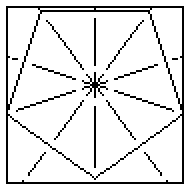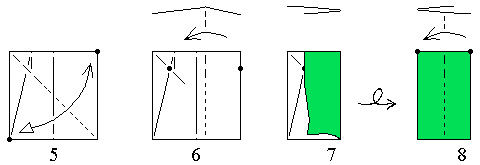
- From now on, crease the entire length of every fold.
Valley fold in half,
so that the pinch made in Step 11 is in the near layer.
- Valley fold
the folded lower corner to exactly meet the pinch made in Step 11.
Note: If folded exactly, the pinch made in Step 11 is exactly 35 percent of the way
in from the open edge of the paper. (35 percent is a little more than one-third.)
This means that all 10 central angles of the pentagon will be almost exactly 36 degrees,
causing the pentagon to be almost perfectly regular.
Here is the math:
1 - 2 * sin(36 deg.) / (1+ cos(36 deg.) ) = 0.35016
On a 6 inch square, the error is less than one-quarter of the thickness of the paper.
- Valley fold
the new flap in half.
- Valley fold,
so that the main diagonal lines up with the new edge.
- Like so. Turn over from side-to-side.
|







